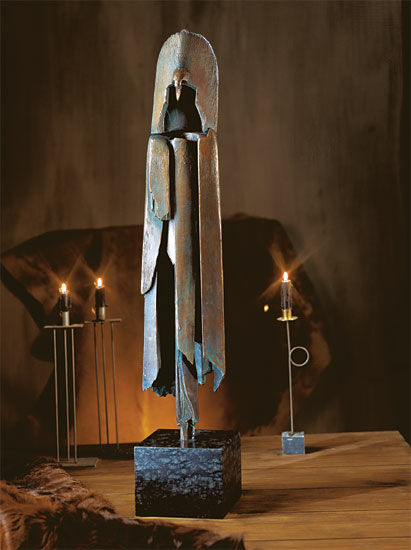Sculpture "The Shaman", bronze
Sculpture "The Shaman", bronze
Quick info
ars mundi Exclusive Edition | limited, 199 copies | numbered | signed | hallmarked | bronze + diabase | handmade | polished | patinated | dimensions 94 x 19 cm (h/w)| weight 18 kg
Detailed description
Sculpture "The Shaman", bronze
Finke graduated from the Hochschule für Bildende Künste in Berlin and was a master-class student of Paul Dierkes and Renée Sintenis. He understood like no other, the visualisation of the spirit that animates the outer shell. He gave his sculpture drama and expressiveness. The interplay of candlelight and open fire provides a magical liveliness to Finke's creation: Is the spirit of the shaman returning from his flight across primaeval landscapes? The flight of his soul into the supersensible spirit world gives him the power to banish evil spirits or make good spirits favourable to people. Since time immemorial, shamans have been putting themselves into ecstatic trances through drumming and self-hypnosis. They are sending their subconscious on a magical journey to heaven. The religious roots of shamanism and the healing powers of those witch doctors can be traced back to the Stone Age, the roots of humanity. Bird-like creature from another world that opens the view into the depths of our soul and an unknown past.
Limited world edition 199 copies. ars mundi Exclusive Edition made of fine bronze. Hand-cast using the Lost-Wax-Process, hand-polished and patinated, with artist's signature and foundry hallmark. Total height 94 cm, width 19 cm. Diabase base 20 x 15 x 20 cm (w/h/d). Weight 18 kg.
About Dieter Finke
1939-2011 - Sculptor
Born in Berlin in 1939, Dieter Finke found his artistic expression already at an early age. From 1959 to 1965 he studied sculpture under Paul Dierkes and Renee Sintenis at the Hochschule für Bildende Künste in Berlin. Since then, he has constantly expanded and changed his creative approach to material and colour, form and space. His wood and bronze sculptures are reduced to the essential. This is especially evident in his filigree animal sculptures, where the shape is hinted at rather than filled in, leaving a space for the viewer's imagination.
Finke lived and worked alternately in Berlin and New York. His enormous creative power did not shy away from painting, drawings, picture objects and photo collages, resulting in an extensive oeuvre exhibited in famous galleries in Berlin, Hanover, Hamburg and New York.
Dieter Finke passed away in 2011.
An alloy of copper with other metals (especially with tin) used since ancient times.
When casting bronze, the artist usually applies the lost-wax technique which is dating back more than 5000 years. It's the best, but also the most complex method of producing sculptures.
First, the artist forms a model of his sculpture. It is embedded in a liquid silicone rubber mass. Once the material has solidified, the model is cut out. The liquid wax is poured into the negative mould. After cooling down, the wax cast is removed from the mould, provided with sprues and dipped into ceramic mass. The ceramic mass is hardened in a kiln, whereby the wax flows out (lost mould).
Now we finally have the negative form, into which the 1400° C hot molten bronze is poured. After the bronze had cooled down, the ceramic shell is broken off and the sculpture is revealed.
Now the sprues are removed, the surfaces are polished, patinated and numbered by the artist himself or, to his specifications, by a specialist. Thus, each casting becomes an original work.
For lower-quality bronze castings, the sand casting method is often used which, however, does not achieve the results of a more complex lost-wax technique in terms of surface characteristics and quality.
Graphic or sculpture edition that was initiated by ars mundi and is available only at ars mundi or at distribution partners licensed by ars mundi.
Term for an art object (sculpture, installation), which is produced in multiple copies in a limited and numbered edition according to the artist‘s will.
Artist's multiples have been called the most accessible and affordable art on the market.
A plastic work of sculptural art made of wood, stone, ivory, bronze or other metals.
While sculptures from wood, ivory or stone are made directly from the block of material, in bronze casting a working model is prepared at first. Usually, it is made of clay or other easily mouldable materials.
The prime time of sculpture after the Greek and Roman antiquity was the Renaissance. Impressionism gave a new impulse to the sculptural arts. Contemporary artists such as Jorg Immendorf, Andora, and Markus Lupertz also enriched sculptures with outstanding works.









